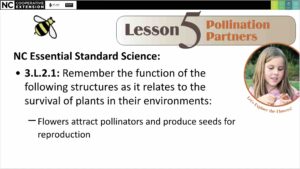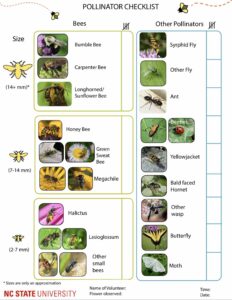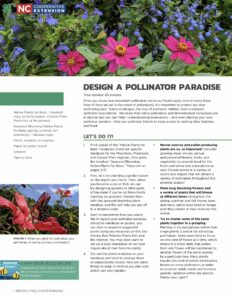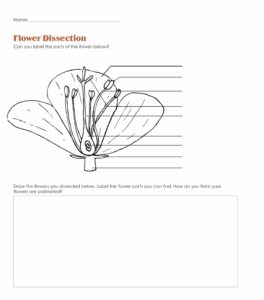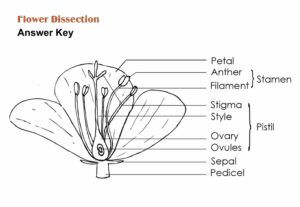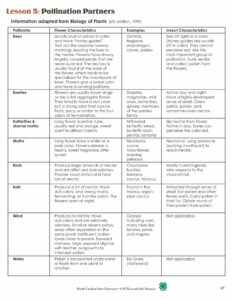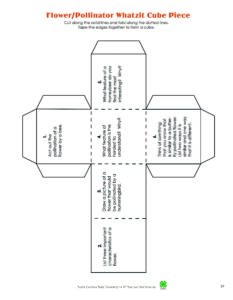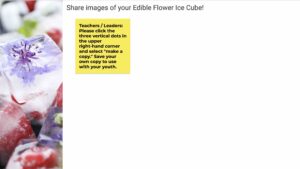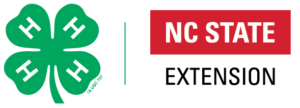Lesson 5: Pollination Partners
Purpose
Students will learn the function of the flower, including the processes of pollination and fertilization. Students will explore the relationship between the shape of the flower and the way it is pollinated. They will understand the flower as it relates to fruit and seed production.
Time Needed
45 minutes to 1 hour
Materials (For 30 Students)
- Different types of flowers collected from a garden, nursery, flower shop
- 30 magnifying glasses
- Sketching paper and pencils
- 2 paper blowouts (uncurls when you blow)
- Hand-crafted flowers (see below)
- Hand-crafted bee puppet
- Yellow sticky tape
- Water spray bottle filled with water and a few drops of a light essential oil
- Construction paper
- paper plate
- 5, 1-oz. plastic cups
Optional
- Butterfly wings and antenna (handcrafted or store-bought)
- Dissecting or stereo microscope
- Slide microscope
Background Information
Seed production occurs in plants as the result of different methods of pollination. Bees, hummingbirds, bats, beetles, wind, water, flies, moths, and butterflies transfer pollen from one flower to another. The flower contains the pollen-producing male organ, the stamen, and the pollen- receptive female organ, the pistil. Flowers have adapted their shape, scent, and color to attract specific pollinators. As the pollinators seek out nectar and pollen to feed themselves, they enable plants to produce fruits and seeds. Bees, the most important and productive pollinators, pollinate over 1/3 of the food crops we consume.
Focus Questions
- What is the function of the flower?
- What are the different ways a flower is pollinated?
- What are the parts of a flower important for pollination by bees?
Lesson Slides
Lesson Five Slides
Click on “File” and then select “Make a Copy” of the lesson four slide deck to use with your youth.
Scratching the Surface
Instructions
Close your eyes and imagine that you are in the middle of a flower garden. Sunflowers tower over you, daisies are tickling you, and you can smell the spiciness of the chive flowers.
What do you see? Perhaps insects are buzzing around, and birds are chirping. What do the flowers look like?
Can someone describe what his or her favorite flower looks like? Maybe you imagine the long bugles of a trumpet vine or the unfurled spiral of a rose.
Is there anything visiting the flowers? What? Butterflies, bees, birds? What are they finding in the flower? They might be finding nectar and pollen for food. Why is this important?
Have the students discuss with their neighbors why pollination is important for the flowers and the pollinator. Encourage a few students to share their ideas with the group.
Pollinator Haven
Explore the pollinator garden at Lee County Cooperative Extension. What pollinators do you notice? Which flowers do they visit?
Pollination
Ever wonder why bees pollinate flowers? What’s it in for the bees? What do the flowers get out of it? Watch this animated video of the act of pollination. Look for the relationship between the bees and the flowers they visit.
Pollinator Checklist
Visit your garden, your playground, wherever you go and try to find these common pollinators!
Pollinator Paradise
Do you love pollinators? This optional activity walks you through creating a pollinator paradise garden. For even more activities about pollinators, ask your local 4-H agent for more information about our bee curricula: Busy World of Bees and Hive Helpers.
Digging In
Instructions
If you have access to a garden, begin by letting the students collect two to four flowers. Encourage them to collect flowers that have different shapes and colors. If your school doesn’t have a garden, look for weeds that have begun to flower or ask your local florist for leftovers.
Consider collecting flowers that are perfect (with pistil and stamen), male flowers that just have a stamen, and female flowers that just have a pistil. You might also contact your county Extension center and see if they know of a local nursery that may let you “deadhead” their flowers.
Perfect flowers (contain stamen and pistil)
- Petunia
- Snapdragon
- Lilies
- Iris
- Alstromeria
- Tulip
- Rose
Plants with separate male and female flowers
- Begonia
- Daisies
- Many trees (birches, oak, sycamore, maple)
- Squash
Let each student have a flower to briefly examine and ask them to share what they observe. What parts can they identify? Sketch on the board each part they name. During the discussion, ask the students to describe the role of each flower part as they name it. What is the purpose of the petals? The pollen?
Lead into a conversation about pollination, and what the different pollinators are, and how it relates to the morphology or shape of the flower. Use the interactive demonstrations described below to illustrate the relationship of the pollinator to the shape, smell, and color of the flower:
- Flowers pollinated by bees: Bees prefer flowers that have landing surfaces. Landing surfaces can be the petals of a daisy flower or the lip of a snapdragon. To make a daisy flower, glue yellow petals around the edge of a heavy-duty paper plate. Glue 1-ounce plastic cups onto the plate to simulate the individual flowers that make up a daisy. Crumple up yellow tape, sticky side out, and stick to the rim of cups. Give a student volunteer a bee hand puppet (homemade from a black stretchy glove or store-bought). Have them pretend to get nectar from the cups by sticking their fingers in the cup and as they make the motion, the sticky tape “pollen” should adhere to the puppet (you may have to “help” the pollen adhere). Bees have short tongues, or proboscis, to collect nectar as they visit flowers. The pollen clings to their legs and as they move to other flowers, some of the pollen will rub off onto the flower’s stigma. Bees often intentionally collect pollen, they are the most efficient pollinator. Why do the bees need nectar and pollen? Nectar provides food or energy for the adult insects and the pollen is a food source for the young bees or larva in the hive. Follow up by showing real examples of flowers like the snapdragon, foxglove, or other flowers that bees crawl into and pollinate. Ask the students if they have ever seen bees crawl into a flower in nature or in a garden.
- Flowers pollinated by butterflies: Create a long, tubular, orange (or red) flower out of construction paper. Have one student be the “flower” and hold it out to the student volunteering to be the “butterfly.” Give the butterfly student a paper blowout proboscis to gather nectar from the bottom of the flower. To show how a butterfly helps with pollen, stick yellow tape “pollen” to their leg and mention that pollen transfer tends to be more accidental for butterflies as they are simply looking for nectar and not pollen. Butterflies are, therefore less, effective than bees. Follow up by showing a real flower that butterflies would pollinate, such as a flower from lantana, pentas, verbena, or butterfly bush
- Flowers pollinated by moths: Moths prefer long, tubular flowers that allow their long proboscis to unfurl into and reach the nectaries nestled at the end. Most moths are active at night, so they prefer white flowers that attract them with a heavy musky scent. Create a similar tubular flower out of white paper. Turn off most of the lights and hold up the white flower and the orange flower. Ask the students which one is most visible. Next, spray a mist of scented water lightly into the air and tell them that at night, moths rely primarily on their sense of smell. Have a volunteer student demonstrate pollinating the white flower.
Have the students dissect their flowers, encouraging them to find the different parts and to wonder what type of pollinator visits the flower. Use the dissecting microscope and/ or a magnifying glass to look closely. Students should sketch and describe two or three different flowers. To wrap up, ask the students to share their findings and guide the discussion about the relationship of their flower to the pollinator.
Flower Parts
Use this glossary of terms to help your students in understanding the different parts of a flower and their functions.
Petal
- Attracts pollinators or aids in pollination with color & shape.
Sepals
- Protects the unopened flower bud.
Stamen
- The male part of the flower; includes the anther at the end of the filament.
Anther
- End of the stamen; produces pollen.
Filament
- Part of the stamen that supports the anther.
Pistil
- The female part of the flower; includes collectively the stigma, style, and ovary.
Stigma
- Sticky end of the pistil where the pollen from the anthers must land for pollination and fertilization to occur.
Style
- Part of the pistil is a long stalk that holds up the stigma.
Ovary
- Part of the pistil usually found at the base of the style (but not always). The ovary matures into a fruit once fertilization occurs. Contains the ovules, or developing seeds.
Ovules
- Seeds that grow into new plants.
Flower Dissection
Use this student handout to nurture understanding and identification of the different flower parts.
Flower Dissection Key
Show this flower dissection key if your students need to remember the different parts.
Digging Deeper
Instructions
Use these additional activities to further build understanding around flower parts and pollinators.
- Students can press petunias or another flower that has both the male and female parts. Have them carefully open the flower and press it flat onto the inside of a folded sheet of paper. Students should write their name on the paper, fold it closed, and then put it into a plant press. After the flower has dried, students can label the different parts and laminate it as a guide for further study. Some plants have male and female flowers. Students can also find and press these flowers.
- Students can collect pollen, and transfer it to a glass slide. Put a drop or two of water (or iodine to stain) on the pollen and gently top with a coverslip. Under a compound microscope, they can see the pollen grains. Small stigmas and petals might also be examined under a microscope.
- Catch a honeybee or bumblebee. Put it in a freezer. Once it is frozen, take it out and push a pin (insect pins work best, but dressmaker’s pins will be fine) through the thorax. Stick the pinned insect on a piece of Styrofoam or cardboard. Let students examine it closely with a hand lens. Ask questions like, “Can you see the hairs on the leg? Why is it good for a bee to have hair? Is there any pollen on the bee? Can you see its proboscis? What is this used for?”
Special Pollinator Stories
Insects pollinate most of the world’s flowering plants. Many have evolved to have special relationships with a specific insect pollinator. Other animals, like birds, bats, and even a few mammals, can also play a role in pollination. Some plants use wind or water to aid in pollination, and some even pollinate themselves. Show students the photos from the Lesson Five Slides, and engage them in a discussion on what they observe.
Bees are the most productive pollinators because they intentionally collect pollen for their larvae. Their legs have bristles that act as a pollen brush. The first two pairs of legs brush pollen from the body and the third pair forms a pollen comb that collects pollen from bristles. The comb forces pollen into the pollen baskets on the legs. Bees have a sucking tongue (shorter than the butterfly’s and moth’s) that sips nectar. Then bees regurgitate into honey, which is food for the rest of the hive.
Many plants have developed complex paths that force pollinators to follow a certain route into and out of the flower. This ensures that the anther and the stigma come into contact with the pollinator and in the proper order. The lady’s slipper orchid is an example of this. The Ophrys orchid resembles a female bee, wasp, or fly. The males of this insect species emerge in the spring before the females.
The orchids blooming coincides with the emergence of the male insects. The male insects are tricked by the flower’s appearance and scent into mating with the orchid flowers. During the visit to the flower, the pollen rubs onto the insect’s body. When the insect visits another orchid, the pollen is deposited, thereby pollinating and fertilizing the flower. The female insect emerges slightly later, mates, and lays her fertilized eggs.
In a spirited tale of symbiotic relationships, the yucca moths are the only pollinator for the yucca flower. The female moth rolls a tight ball of pollen from one yucca flower, flies to another flower, and packs the sticky pollen into the stigma, fertilizing the flower. She then lays her eggs in the ovary wall. The moth larvae and seeds develop simultaneously with the larvae eating some of the seeds.
The hawkmoth is a moth that hovers above the flower, inserting its long mouthparts into the floral tube to reach the nectar at the bottom. Hawkmoth-pollinated flowers don’t have landing platforms, traps, or other specialized adaptations.
Hummingbird-pollinated flowers tend to produce a certain amount of nectar that is drained by the birds. After the bird leaves to hunt for more nectar the flowers will refill with more nectar, to attract more birds and ensure successful pollination.
Pollination Partners
This chart details the different types of flowers and the pollinators that will visit them.
Assessment
Flower-Pollinator Whatzit Cube Game – Instructions
Adapted from Whatzit tic-tac-toe (Tishman, Andrade, 1997), this assessment encourages students to use analogies, evaluate important features of flowers, and think creatively about pollination.
- Cut out and assemble (or have students do this) dice, and make copies of the Whatzit worksheet.
- Divide the class into partners or small groups, and have them work through the whatzit game. Students should fill out the worksheet as they are completing the game. Use the worksheets to find areas of strength and uncertainty in students.
Flower + Pollinator Whatzit Cube Handout and Response Sheet
Print out copies of the whatzit cube handout and the response sheet.
Beyond the Garden Gate: Activities to do at home
Flower Pounding
Flower pounding is a crafty way to preserve different types of flowers.
- Place a paper towel on a heavy book or the ground.
- Cover the paper towel with a piece of muslin cloth.
- Place thin flowers or petals on the cloth.
- Cover with another paper towel.
- Hammer the flowers into the muslin, and carefully peel off the paper towel.
Experiment with different flowers. Some preserve perfectly, like pansies, marigolds, verbena, and geraniums. Others leave very different effects, like the watery impression of impatiens or the dark veins from some leaves.
Edible Flowers
A number of tasty edible flowers provide delightful nibbling snacks. Borage, begonias, rose petals, pansies, calendula, chive blossoms, dianthus, and bee balm are all edible. For a complete list of edible flowers, download the Garden Grazing Guide.
Edible Flower Ice Cubes
For a marvelous addition to your favorite drink, make flower ice cubes. Simply fill an empty ice cube tray with your favorite edible petals or flowers. Gently cover with water, and place it in the freezer. After a few hours, plunk the ice cubes into your glass and enjoy!
Edible Flower Ice Cube – Jamboard
Make a copy of this jamboard to use with your students. Encourage them to try this at home and share pictures of what they made.

